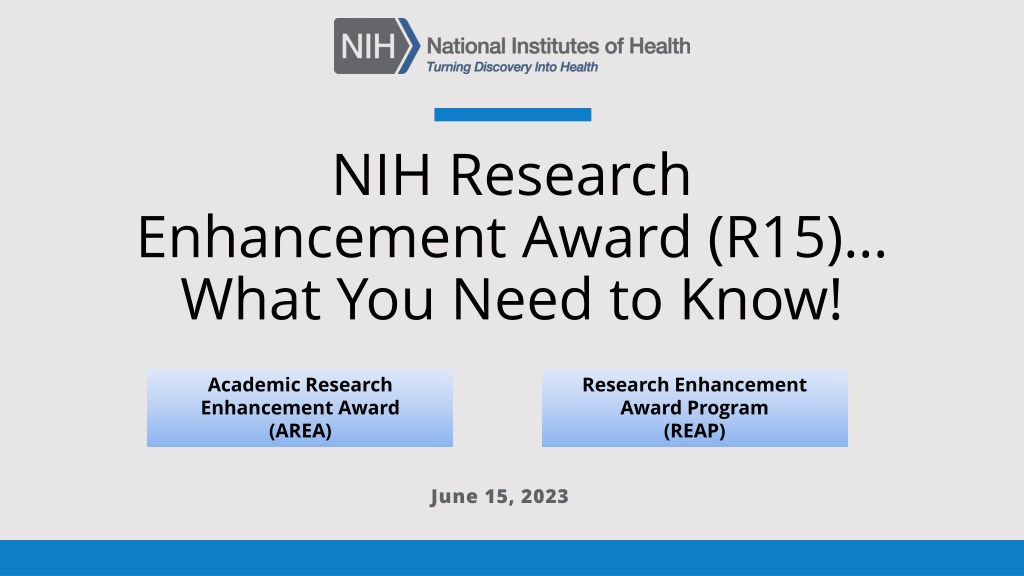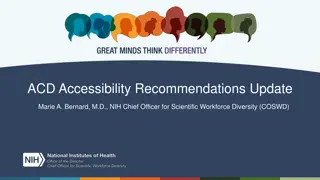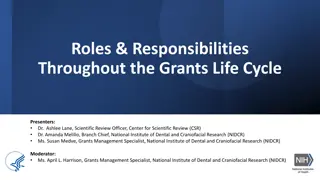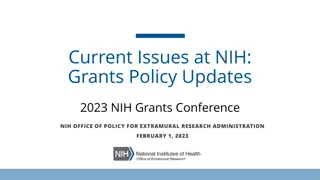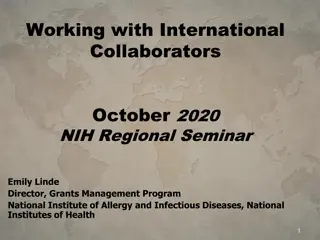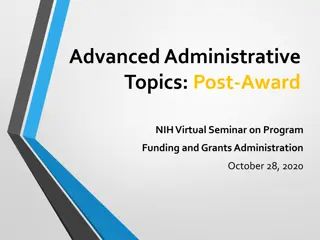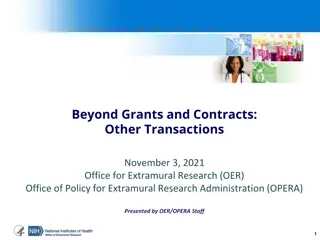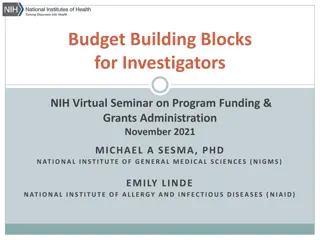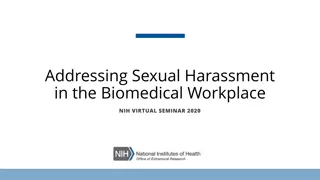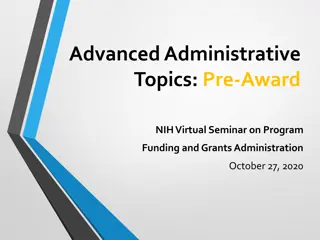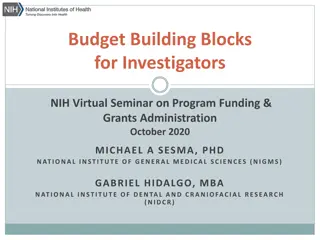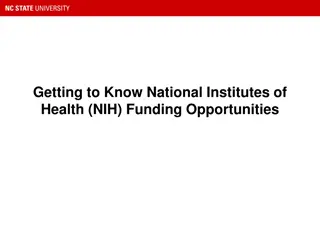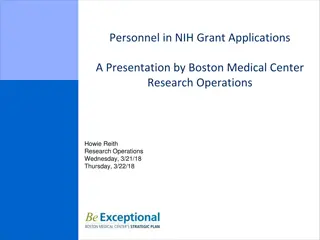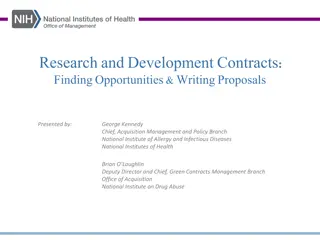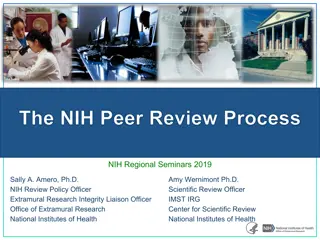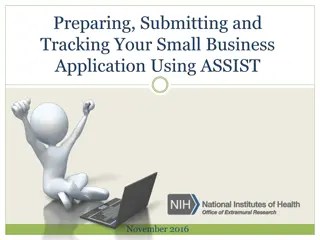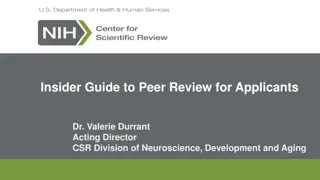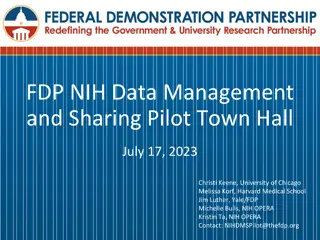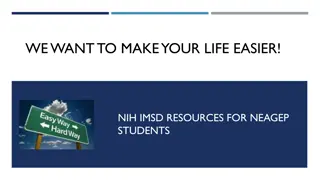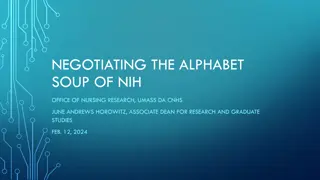Understanding the NIH Research Enhancement Award (R15) Program
Explore the NIH Research Enhancement Award (R15) Program, its goals, differences from the R01 grant, eligibility criteria, and strategies for success. Learn about the impact of R15 grants, active awards landscape, and how it supports small-scale research projects and enhances the research environment at institutions.
Download Presentation

Please find below an Image/Link to download the presentation.
The content on the website is provided AS IS for your information and personal use only. It may not be sold, licensed, or shared on other websites without obtaining consent from the author. Download presentation by click this link. If you encounter any issues during the download, it is possible that the publisher has removed the file from their server.
E N D
Presentation Transcript
NIH Research Enhancement Award (R15) What You Need to Know! Academic Research Enhancement Award (AREA) Research Enhancement Award Program (REAP) June 15, 2023
Meet Your Presentation Team MODERATOR PRESENTERS Anne Gershenson, Ph.D. Program Director National Institute of General Medical Sciences (NIGMS) Liz Perruccio, Ph.D. Program Director National Institute of Nursing Research (NINR) Charles Ansong, Ph.D. Program Director National Institute of General Medical Sciences (NIGMS) 2
In todays session, you will learn The answer to the question What is the NIH R15 Program? Differences between the R15 and the R01 Specifics of the R15 Notices Of Funding Opportunities (NOFOs) How to determine eligibility for the R15 program Differences between the Academic Research Enhancement Award (AREA) and Research Enhancement Award Program (REAP) Some strategies for success 3
What is the goal of the R15 program? Support meritorious, small scale research grants at institutions that do not receive substantial NIH funding Provide research opportunities to students who might not otherwise have access to them Strengthen the overall research environment at the institution Credit: iStock 4
R15 landscape: Active awards across NIH NIGMS 33% NICHD 8.0% NCI 8.0% NHLBI 7.3% NIAID NINDS 6.1% NIA NIMH 23 participating NIH Institutes/Centers All Other ICs 67% 6.5% 5.3% 5.2% >1100 active projects 5
How is the R15 different from an R01? R15 R01 Impact: Publishable, disseminated, and important scientific contribution to the research field(s) involved Scope: Could be limited due to limitations of facilities and personnel Impact: A sustained, powerful influence on the research field(s) involved Scope: Broader, could extend across one or multiple fields Must describe research opportunities for students Not relevant Must describe how the award will strengthen the research environment of the institution Not relevant Foreign Institutions: Non-domestic (non-US) entities and non-domestic (non-US) components of US organizations are not eligible but foreign components are allowed Foreign Institutions: Non-domestic (non-US) entities and non-domestic (non-US) components of US organizations are eligible 6
Key features of the R15 Makes an important scientific contribution to the research field(s) involved; not a training grant 3-year project period Provides up to $300,000 in direct costs over 3 years Includes a 12-page research strategy o Same scored review criteria as R01 with added emphasis on student engagement Can have multiple PIs if all PIs are eligible for the same R15 NOFO Renewable Credit: iStock 7
R15 Notices Of Funding Opportunities (NOFOs) Academic Research Enhancement Award (AREA) for Undergraduate-Focused Schools PAR-21-154 (Clinical Trial (CT)) PAR 21-155 (no CT) Research Enhancement Award Program (REAP) for Health Professional and Graduate Schools PAR-21-357 (CT) PAR-22-060 (no CT) Some institutions may be eligible for BOTH the AREA and REAP programs 8
Defining Undergraduate-focused schools and Health Professional schools (refer to NOFOs) Undergraduate-Focused Schools o Confer baccalaureate degrees in biomedical sciences o An undergraduate-focused institution/component is one in which the undergraduate enrollment is greater than the graduate enrollment Health Professional Schools o Health professional schools and colleges are accredited institutions that provide education and training leading to a health professional degree including but not limited to: BSN, MSN, DNP, MD, DDS, DO, PharmD, DVM, OD, DPT, DC, ND, DPM, MOT, OTD, MS- SLP, CScD, SLPD, AuD, MSPO, MSAT, and MPH o Accreditation must be provided by a body approved for such purpose by the Secretary of Education 9
Am I eligible for a REAP R15? Cannot be the PI of another NIH research grant at time of award Primary appointment in a Health Professional School or Graduate School, including nursing programs/schools NIH Funding for the institution as a whole cannot exceed $6M/year (in both direct and F&A/indirect costs) in 4 of the last 7 years For more information: https://grants.nih.gov/grants/funding/R15-Eligibility-Decision-Tree.pdf 10
Am I eligible for an AREA R15? Cannot be the PI of another NIH research grant at time of award Primary appointment is NOT in a Health Professional School or Graduate School o AREA includes engineering and biomedical engineering (BSE & MSE) Individual school within the parent umbrella institution has a greater undergraduate than graduate student enrollment NIH Funding for all of the non-health professional components of the institution cannot exceed $6M/year (in both direct and F&A/indirect costs) in 4 of the last 7 years For more information: https://grants.nih.gov/grants/funding/R15-Eligibility-Decision-Tree.pdf 11
Determining institution financial eligibility Utilize NIH RePORT or NIH Awards by Location & Organization to determine organization funding levels for R15 Eligibility o Follow the directions at this link https://grants.nih.gov/grants/funding/Determing- Organization-Funding-Levels-R15-Eligibility.pdf For institutions with multiple campuses, eligibility can be considered for each individual campus (e.g., main, satellite, etc.) only if a Unique Entity Identifier (UEI) and NIH Institutional Profile File (IPF) number are established for each campus. For institutions that use one UEI or NIH IPF number for all campuses, eligibility is determined for all campuses together (see: NOT-OD-21-135) 12
How do I document institution eligibility? Oh no, I forgot to upload a signed letter from my Provost or similar institutional official verifying that my institution meets the eligibility criteria! Don t let this be you! Your application will be withdrawn Credit: iStock 13
Painted Desert University Painted Desert University College of Arts & Sciences U>G (Undergraduate>Graduate) $1M NIH Funding College of Nursing U>G $600K NIH Funding Lisa David School of Public Health U<G $200K NIH Funding Thomas School of Medicine G Only $5M NIH Funding Cara College of Engineering & Applied Sciences U>G $300K NIH Funding Non-Health and Health Professional Schools Marcus
Painted Desert University: NIH Funding Painted Desert University: NIH Funding Non-Health Professional Schools: $1.3M AREA Eligible College of Arts & Sciences U>G (Undergraduate>Graduate) $1M NIH Funding College of Engineering & Applied Sciences U>G $300K NIH Funding Marcus Lisa All Schools & Colleges: $7.1M NOT REAP Eligible College of Nursing U>G $600K NIH Funding School of Public Health U<G $200K NIH Funding School of Medicine G Only $5M NIH Funding Thomas Cara David
PUTTING THE APPLICATION TOGETHER
Its time to put the application together! Read the NOFO carefully Sketch out some specific aims Find out which NIH Institute(s) funds this kind of work o Check NIH RePORTER Matchmaker tool (https://reporter.nih.gov/matchmaker) See if the Institute(s) participates in the NOFO of interest Reach out to the Program Officer (PO) listed in the NOFO Credit: iStock 17
The art of crafting an R15 Pick a compelling, scientifically meaningful research topic o Clear hypothesis and well justified o Publishable data Make the plan feasible with o Resources (facility and personnel) o Effort o Students o Environment (institutional support) Set a realistic/appropriate scope o 3-year timeline Credit: iStock 18
Writing the Research Strategy Read the review criteria and program goals o Make sure you address the goals & criteria o Reviewers are asked to comment on these specifically Include preliminary data where possible o Supports your hypothesis o Shows reviewers that you can do the work Describe how students will be involved Credit: Adobe Stock Photos 19
Writing the Research Strategy Clinical Trial Required Must be small scale o Mechanistic and/or minimal risk Provides clinical trial research experience for undergraduates, health professional and/or graduate students in a controlled environment Students may: o Participate in experimental design o Collect and analyze data o Develop presentations and publications o Participate in lab/research meetings Students should be a major component of the research team Remember students working on a clinical trial must have clinical trial education, like CITI or similar training For more information: https://grants.nih.gov/policy/clinical-trials.htm 20
Student involvement should be meaningful Number of students o Include thoughts about how to recruit a diverse group of students, including what type of student e.g., undergraduate, graduate students, health professional students o For AREA R15: Number of undergraduate researchers > number of other researchers o For REAP R15: What type of student researchers? Undergraduates? Graduate students? Health professional students? Quality of student involvement o It is not sufficient to say there will also be a couple of students (with an unspecified or insignificant role) o Student involvement should result in students co-authoring publications!! 21
Writing the Biosketch Include experience mentoring undergraduate, health professional and/or graduate students in research in the Personal Statement Indicate which peer-reviewed publications or other research products involved undergraduate, health professional and/or graduate students under your supervision Credit: Adobe Stock Photo 22
Facilities, Data & Resources Facilities & Resources o A number of R15 specific instructions, e.g., a plan for recruiting students from diverse backgrounds Data Management and Sharing (DMS) Plan o See https://sharing.nih.gov/ o Includes data and metadata sharing use of established repositories is encouraged o The NIH website has sample DMS Plans o Talk to a Program Officer to discuss your DMS plan and associated costs Resource Sharing Plan o Some examples of resources that might be developed: Experimental resources such as model organisms, plasmids, bespoke molecules, etc. Computational resources such as software (may also be listed in DMS Metadata section if used for data analysis) Read the NOFO for general and R15 specific directions! 23
Putting the budget together R15 is a multi-year funded award Budget for all years is requested in the first budget year $300,000 direct cost limit Can support a range of expenses o Research needs o Student compensation o Collaborator (subawards) o DMS costs Credit: @Erin O Sullivan o Travel 24
Student compensation Appropriate compensation = commitment o Fixed stipends for undergraduates are not allowed on R15 awards. Stipends are payments made to individuals under fellowship or training awards. o Applicants should describe student compensation explicitly. o Students within the institution should be treated equitably - undergraduate students who are compensated from the R15 grant or other institutional funds should receive at least the national minimum wage. o Compensation through course credit hours towards graduation is allowable but must be justified. o Undergraduate summer salaries! Read the NOFO for general and R15 specific directions! 25
Where will my application be reviewed? R15s are clustered within standing study sections or Special Emphasis Panels (SEPs) Optional Assignment Request form o Specify scientific areas of expertise needed for application review o Request preferred study section o https://nexus.od.nih.gov/all/2023/01/27/encouraging-use-of-the-phs- assignment-request-form-in-applications/ NIH Center for Scientific Review (CSR) Assisted Referral Tool (ART) recommends potentially appropriate study sections NIH CSR makes the final call on application assignments! 26
Help your reviewers by writing a great application! Lay things out logically Write for a broad audience Be clear and concise, don t use jargon Organize the page Proofread Know what the reviewers are looking for and give it to them! 27
ADDITIONAL RESOURCES & OPPORTUNITIES
National Research Mentoring Network (NRMN) Mentoring for Undergraduate & Graduate Students, Post- Docs, Research Scientists, Faculty & Academic Administrators Provides evidence-based mentorship professional development programming that emphasizes the benefits and challenges of diversity, inclusivity and culture MyMentor virtual mentoring MyNRMN social networking Webinars including grant writing Mentor training For more information: https://nrmnet.net/ 29
Support for Research Excellence (SuRE) Resource Center University of Kentucky FREE Resources Helps qualifying institutions on their path toward building and sustaining a research infrastructure Provides grant writing training, consultation, and mentoring to help faculty and staff at SuRE-eligible institutions overcome barriers to secure research funding For more information: https://www.research.uky.edu/sure-resource-center 30
Instrumentation grant program for resource- limited institutions (RLI-S10) NIH Unite E initiative to support acquisition of modern scientific instruments by resource-limited institutions: PAR-23-138 Credit: iStock Credit: iStock Program Goals Program Features Provide instruments for research and teaching Enhance biomedical research capacity at resource-limited institutions Award Amount: $25,000 to $250,000 Instruments for basic, translational, clinical, or biomedically-related behavioral research For more information: https://grants.nih.gov/grants/guide/pa-files/PAR-23-138.html RLI-S10 contact: Dr. Dorothy Beckett dorothy.beckett@nih.gov 31
Final thoughts on R15s Visit the NIH R15 website o https://grants.nih.gov/grants/funding/r15.htm Find and read the relevant notice of funding opportunity (NOFO) PAR-21-357 (REAP R15 Clinical Trial (CT) required) PAR 21-154 (AREA R15 CT required) PAR-22-060 (REAP CT not allowed) PAR-21-155 (AREA CT not allowed) Visit the R15 website for the relevant NIH Institute/Center (IC) Talk to a relevant Program Officer! 32
Thank you! You, our audience All members of the NIH R15 Program Advisory Committee The NIH Grants Events Team at the Division of Communication & Outreach in the NIH Office of Extramural Research Cynthia Dwyer, DeRon Turner, Sophie Barry, Kim Biondi, & Marisa Higgins 33
Contact Us R15 WEBSITE https://grants.nih.gov/grants/funding/r15.htm R15 IC CONTACTS Check the relevant R15 NOFO for contact info EVENT CONTACT NIHGrantsEvents@nih.gov TWITTER @NIHgrants (This Event: Hashtag #NIHR15)
Your NIH Q&A Panel Charles Ansong, Ph.D. Program Director, National Institute of General Medical Sciences (NIGMS), NIH Anne Gershenson, Ph.D. Program Director National Institute of General Medical Sciences (NIGMS), NIH Liz Perruccio, Ph.D. Program Director, National Institute of Nursing Research (NINR), NIH Mahua Mukhopadhyay, Ph.D. Program Director Eunice Kennedy Shriver National Institute of Child Health and Human Development (NICHD), NIH Carmen Bertoni, Ph.D. Scientific Review Officer Center for Scientific Review (CSR), NIH Jeanette Marketon, Ph.D. Receipt and Referral Officer National Institute on Drug Abuse (NIDA). NIH
Support for Research Excellence (SuRE) R16 programs SuRE-First R16: Supports research by faculty investigators who have not been PIs of external research grants ($125K Direct Costs (DC)/yr for up to 4 years, mentored, 6 months of research effort required, not renewable) SuRE R16: Supports research by faculty investigators with prior research experience and no active NIH Research Project Grant (RPG) funding($100K DC/yr for up to 4 years, renewable) Check participating NIH Institutes/Centers Institutional Eligibility o Award undergraduate (B.S./B.A.) and/or graduate degrees in biomedical sciences o At the time of the application, have received no more than $6 million dollars per year (total costs) from NIH RPGs in each of the preceding two fiscal years o Enroll at least 25% of undergraduate students supported by Pell grants based on the most recent 2 years of data or are an accredited medical/health professional school with a historical mission statement that explicitly states that it was founded to educate students from nationally underrepresented backgrounds. For more information: https://www.nigms.nih.gov/about/overview/Pages/SuRE.aspx R16 contact: Dr. Irina N. Krasnova (Irina.Krasnova@nih.gov) 36
Even more resources NIH Grants Process Helpful videos: https://grants.nih.gov/grants/grants_process.htm NIGMS Grant Writing Webinar Series for Institution Capacity Building: https://nigms.nih.gov/training/Pages/Grant-Writing-Webinar-Series-for- Institutions-Building-Research--and-Research-Training-Capacity.aspx Notice of Funding Opportunities (NOFOs): The Annotated NOFO The NIH Application Guide: https://grants.nih.gov/grants/how-to-apply-application-guide.html Submitting an Application: https://grants.nih.gov/grants/forms/submitting-an-application.htm NIH Peer Review Process Information for Applicants: Center for Scientific Review 37
